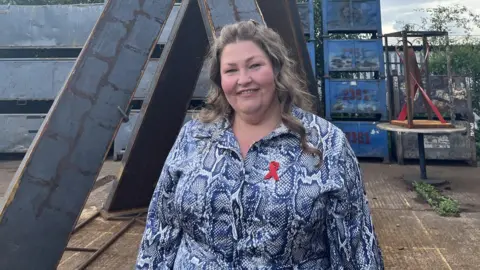Birmingham's HIV and Aids memorial to be 'a beacon of hope'
 BBC
BBCArtists have created an Aids and HIV memorial to challenge the stigma that still surrounds the condition.
More than £180,000 has been raised for the new public sculpture, which is due to be revealed in Birmingham this year.
The 19.6ft (6m) steel sculpture, which depicts two interlocking heart-shaped ribbons, was designed by Garry Jones and made by Luke Perry.
Mr Jones, who lives with HIV, said it would celebrate people living with the disease as well as those who have died.

"This is to remember all those who've got nothing to be remembered by," Mr Jones said. "They didn't have graves, they had no funerals, their dignity was lost.
"This is to make up for that."
The idea for a memorial was ignited following the success of Channel 4 drama It's A Sin, which followed a group of friends during the Aids epidemic in 1980s London.
"It took me back to when I was 21," Mr Jones said.
"You were scared to have sex with anybody then. Now that isn't the case. There is no fear. The fear is the stigma and prejudice that's still there from the 1980s.
"We want this to be a beacon of hope for people to stop the fear, stop the stigma, stop the prejudice."
The majority of people diagnosed with HIV today manage their disease with a single pill a day, which keeps their viral load low enough to be undetectable, meaning it cannot be passed on to someone else.

Rachel Greaves was diagnosed with HIV in 2015 and now runs Positive Peers, a support group that helps people come to terms with their diagnosis. She saw the memorial for the first time this week.
"It was mind blowing," she said. "I certainly felt a feeling of empowerment, that this is going to be in the city centre, and HIV and Aids is going to become a talking point again.
"We're not going to pretend that people aren't living with it, that people haven't died from it. We can encapsulate all of that in this beautiful, absolutely stunning structure.
"As a heterosexual woman, an old fashioned opinion was that I was either a sex worker, or an intravenous drug user. I'm neither, I was unfortunate, but due to becoming HIV positive, I've met so many amazing people and become part of a great community."
Businesses and venues in Birmingham's gay village, where the five-tonne sculpture will be displayed, have helped raise money to build it.

The campaign was set up by Mr Jones with friends Phil Oldershaw, the former operations director of LGBT nightclub The Nightingale, and Andy King, who owns LGBT pub The Fox.
"My best friend was HIV positive," Mr Oldershaw said. "We were told in the early 1990s that he wouldn't see the year 2000 and he did.
"We celebrated right until 2019 when he passed from a different illness. I saw the stigma that he had to go through, so it's important for me to support such a project."
The memorial is being completed at a steel foundry in Cradley Heath by Mr Perry, a renowned public artist. He said the scale and complexity of the project had been difficult to navigate.

"This is probably one of the most intimidating things I've ever made," he said.
"Even though it looks quite simple, the complexity of making those curves in metal is really difficult, sometimes dangerous.
"Just undertaking it, not knowing whether we'd be able to do it, was quite frightening, but ultimately very rewarding."
One of the memorial's heart shaped ribbons will be painted red, while the other will be left to rust. The campaign said it still needed to raise £30,000 to complete the project in time for it to be unveiled on World Aids Day on 1 December.
It is thought the sculpture will be the largest Aids and HIV memorial in the country.
Ms Greaves said she hoped the size of the memorial would help start conversations, and educate more people about the reality of living with HIV in 2022.
"People are still living in isolation and fear, presuming they're going to be stigmatised. This, in 2022, really should not be the case. So to see this, and that it may change perceptions, and we might not have to live in isolation, is fantastic.
"Why do we have to be ashamed?"

Follow BBC West Midlands on Facebook, Twitter and Instagram. Send your story ideas to: [email protected]
